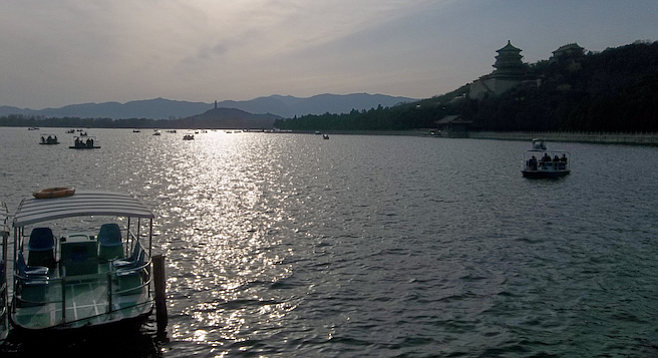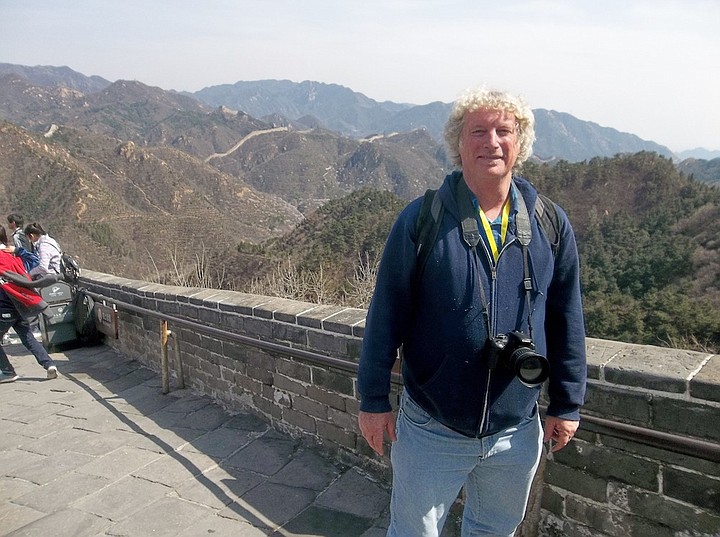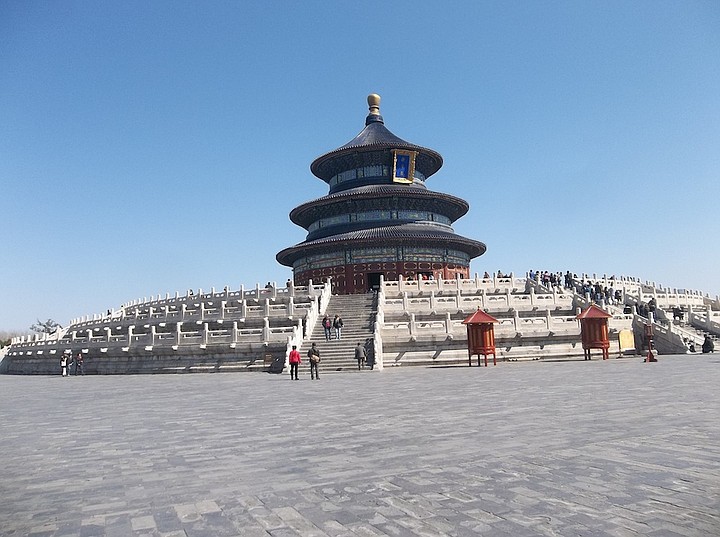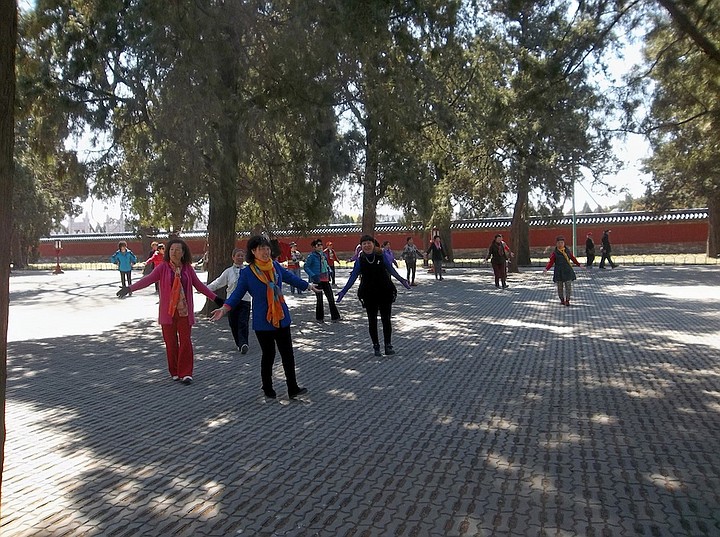 Facebook
Facebook
 X
X
 Instagram
Instagram
 TikTok
TikTok
 Youtube
Youtube

Check out Derek's e-book How to Travel On the Cheap (...and Even for Free!): Turn Your Travel Dreams Into Reality, available in the Amazon Kindle store.
“We Chinese people eat everything. Everything in the sky except for the plane. Everything in the water except for the boat. Everything on the ground except for the table and chairs,” our guide Peng joked.
“Some Chinese eat dog. So when I came to America and saw hot dog on the menu, I thought, ‘You too?!”
There are limits to what I will sample on exotic journeys, but everything I ate in the first few days of my Beijing visit was delicious, especially the Peking duck which I sampled with a crepe, a smattering of soy sauce and veggies. This and the assorted other dishes I enjoyed during our first major dinner helped me enjoy a decent night’s sleep on my second night in China.
I needed my rest, because on the schedule the following morning was a visit to my #1 anticipated site in China: the Great Wall. If I had taken the time to assemble a world travel bucket list, this would be right up there, if not at the top.

There’s more to experiencing the Great Wall, though, than just getting there. You need to do a bit of climbing. Possibly a lot of climbing. Climbing the Great Wall of China is harder than you might think. The slippery top of the wall and uneven steps wind up and up, and the higher you’re able to climb, you just want to keep going for the best views and fewest tourists taking selfies. Along the way, you may be – as I was – asked to join the family photo of a Chinese visitor.
I took my time making my way up the winding edifice and paused along the way several times to savor the moment. It was hard for me to wrap my head around the idea that the Great Wall is 3,600 miles long. Although I didn't find the view to be one of the most spectacular ones of my journeys across the globe, visiting here was, nevertheless, one of the most transcendent travel experiences I’ve had. The Great Wall is certainly one of the most magnificent structures ever erected by our species. It’s probably a myth, though, that it’s the only manmade structure that can be seen from outer space.
My next adventure was in the souvenir shop near the Great Wall. I felt an urge to buy the obligatory “I Climbed the Great Wall” t-shirt. I did so, but not without a subtle reference to my weight by a clerk who openly wondered if I could fit into a Chinese x-large size (I wear a U.S. large) as she patted my belly. I realized she did not mean to be offensive, and I didn't take offense.
The Chinese have a different attitude toward being overweight than we do in the West. They don't wring their hands about delicate sensitivities over this issue. Although I saw very few fat people in China on our trip, I read that obesity is rapidly growing in China. With 46 million obese citizens, China is now second to the U.S. in this department. I doubt, however, that many Chinese wives ask their husbands if the dress they’re wearing makes them look fat.
I then wandered to the other side of the store and examined a miniature Xian terracotta warrior. Another clerk noticed my interest and immediately lowered the price by a third as I walked away.
This brings up the art of haggling. Americans are notoriously bad at this, but it’s wise to practice before you come to China if you want to buy items that aren't overpriced. It’s expected that you will negotiate the price down. Just how far down is the mysterious part. If you want a lower price, but are reluctant to try your hand at haggling, just show an interest in something you are considering purchasing. Then ask the price. Even if it’s an amount you would pay, walk away with a disappointed expression and watch what happens. If there’s nobody behind you after the same item, you probably just earned yourself a nice discount.
The standard bargaining protocol for many vendors and merchants is to write the price down on a notepad. You are then welcome to write your chosen price. From that point, simply negotiate until you reach an agreeable price for both of you.
After leaving the Great Wall, we headed to The Summer Palace, the largest and best-preserved imperial garden in the world. This is one of the most beautiful spots in Beijing. The Chinese call it Yihe Yuan (Garden of Restful Peace).
The gardens, spanning 700 acres, are complemented by artistically detailed bridges, pavilions and walkways. Buddhist temples adorn the grounds. Beautiful cherry blossoms graced the edges of the huge, artificial Kunming Lake during our April visit. A woman painted large calligraphic figures on the sidewalk, as large throngs of people leisurely walked the grounds enjoying a warm, spring afternoon. The landscapes and views can be better appreciated when the crowds are smaller, so it's recommended to avoid visiting on a weekend or holiday.
The Summer Palace was a welcome refuge for emperors during the summer when the Forbidden City could become insufferably hot. The irrepressible Empress Dowager Cixi Cixi apparently embezzled funds intended to build up the Chinese Navy to reconstruct the Summer Palace after it was vandalized during the Second Opium War around 1860. She also had a marble boat constructed that we saw docked on the lake.
After walking the covered walkway that meanders alongside the lake, called the Long Corridor, we decided to take a dragon boat for a ten-minute ride back to our starting point near the Seventeen Arch Bridge. During the brief ride, sunset fell over the lake, creating a mystical setting fit for a Chinese landscape painting.

“If you haven’t visited the Temple of Heaven, you haven’t really been to China,” Peng mused.
Not only is the largest temple complex in China a striking testament to Chinese skills in design and harmony, the outer grounds can be considered Beijing's village recreation center. Locals gather here to participate in a multitude of games and activities.

As we walked into the temple complex on a beautiful, clear morning, a group of middle-aged and elderly women were enthusiastically crooning songs from their youth praising Chairman Mao. Locals were engaged in tai chi, line dancing, poker, mahjong, and a multitude of other physical activities from hacky sack to Taichi paddle. Tourists are also encouraged to join in for some fun and a memorable interaction with the local people.
Peng urged us on, joking, “If you don’t dance with the locals, no lunch.”
Eventually, we made our way to the breathtakingly beautiful Hall of Prayer for Good Harvests. According to the emperor’s feng shui masters, this was the exact point where heaven and earth meet. The beautifully constructed temple features decorative carved marble balustrades, triple eaves, and a solid blue roof symbolizing the color of heaven.
Our final stop in Beijing was the Bird’s Nest stadium, site of the Beijing Olympics. I’d love to have seen the inside of the stadium, but just seeing the exterior with the opportunity for a photo made it a worthwhile stop. The spectacle the world saw here during the opening ceremony of the 2008 Olympics was a reminder that a civilization with 5,000 years of history can be capable of quite remarkable things.
I’d love to have stayed longer to experience Beijing in greater depth, but it was on to explore the intriguing metropolis of Shanghai.


Check out Derek's e-book How to Travel On the Cheap (...and Even for Free!): Turn Your Travel Dreams Into Reality, available in the Amazon Kindle store.
“We Chinese people eat everything. Everything in the sky except for the plane. Everything in the water except for the boat. Everything on the ground except for the table and chairs,” our guide Peng joked.
“Some Chinese eat dog. So when I came to America and saw hot dog on the menu, I thought, ‘You too?!”
There are limits to what I will sample on exotic journeys, but everything I ate in the first few days of my Beijing visit was delicious, especially the Peking duck which I sampled with a crepe, a smattering of soy sauce and veggies. This and the assorted other dishes I enjoyed during our first major dinner helped me enjoy a decent night’s sleep on my second night in China.
I needed my rest, because on the schedule the following morning was a visit to my #1 anticipated site in China: the Great Wall. If I had taken the time to assemble a world travel bucket list, this would be right up there, if not at the top.

There’s more to experiencing the Great Wall, though, than just getting there. You need to do a bit of climbing. Possibly a lot of climbing. Climbing the Great Wall of China is harder than you might think. The slippery top of the wall and uneven steps wind up and up, and the higher you’re able to climb, you just want to keep going for the best views and fewest tourists taking selfies. Along the way, you may be – as I was – asked to join the family photo of a Chinese visitor.
I took my time making my way up the winding edifice and paused along the way several times to savor the moment. It was hard for me to wrap my head around the idea that the Great Wall is 3,600 miles long. Although I didn't find the view to be one of the most spectacular ones of my journeys across the globe, visiting here was, nevertheless, one of the most transcendent travel experiences I’ve had. The Great Wall is certainly one of the most magnificent structures ever erected by our species. It’s probably a myth, though, that it’s the only manmade structure that can be seen from outer space.
My next adventure was in the souvenir shop near the Great Wall. I felt an urge to buy the obligatory “I Climbed the Great Wall” t-shirt. I did so, but not without a subtle reference to my weight by a clerk who openly wondered if I could fit into a Chinese x-large size (I wear a U.S. large) as she patted my belly. I realized she did not mean to be offensive, and I didn't take offense.
The Chinese have a different attitude toward being overweight than we do in the West. They don't wring their hands about delicate sensitivities over this issue. Although I saw very few fat people in China on our trip, I read that obesity is rapidly growing in China. With 46 million obese citizens, China is now second to the U.S. in this department. I doubt, however, that many Chinese wives ask their husbands if the dress they’re wearing makes them look fat.
I then wandered to the other side of the store and examined a miniature Xian terracotta warrior. Another clerk noticed my interest and immediately lowered the price by a third as I walked away.
This brings up the art of haggling. Americans are notoriously bad at this, but it’s wise to practice before you come to China if you want to buy items that aren't overpriced. It’s expected that you will negotiate the price down. Just how far down is the mysterious part. If you want a lower price, but are reluctant to try your hand at haggling, just show an interest in something you are considering purchasing. Then ask the price. Even if it’s an amount you would pay, walk away with a disappointed expression and watch what happens. If there’s nobody behind you after the same item, you probably just earned yourself a nice discount.
The standard bargaining protocol for many vendors and merchants is to write the price down on a notepad. You are then welcome to write your chosen price. From that point, simply negotiate until you reach an agreeable price for both of you.
After leaving the Great Wall, we headed to The Summer Palace, the largest and best-preserved imperial garden in the world. This is one of the most beautiful spots in Beijing. The Chinese call it Yihe Yuan (Garden of Restful Peace).
The gardens, spanning 700 acres, are complemented by artistically detailed bridges, pavilions and walkways. Buddhist temples adorn the grounds. Beautiful cherry blossoms graced the edges of the huge, artificial Kunming Lake during our April visit. A woman painted large calligraphic figures on the sidewalk, as large throngs of people leisurely walked the grounds enjoying a warm, spring afternoon. The landscapes and views can be better appreciated when the crowds are smaller, so it's recommended to avoid visiting on a weekend or holiday.
The Summer Palace was a welcome refuge for emperors during the summer when the Forbidden City could become insufferably hot. The irrepressible Empress Dowager Cixi Cixi apparently embezzled funds intended to build up the Chinese Navy to reconstruct the Summer Palace after it was vandalized during the Second Opium War around 1860. She also had a marble boat constructed that we saw docked on the lake.
After walking the covered walkway that meanders alongside the lake, called the Long Corridor, we decided to take a dragon boat for a ten-minute ride back to our starting point near the Seventeen Arch Bridge. During the brief ride, sunset fell over the lake, creating a mystical setting fit for a Chinese landscape painting.

“If you haven’t visited the Temple of Heaven, you haven’t really been to China,” Peng mused.
Not only is the largest temple complex in China a striking testament to Chinese skills in design and harmony, the outer grounds can be considered Beijing's village recreation center. Locals gather here to participate in a multitude of games and activities.

As we walked into the temple complex on a beautiful, clear morning, a group of middle-aged and elderly women were enthusiastically crooning songs from their youth praising Chairman Mao. Locals were engaged in tai chi, line dancing, poker, mahjong, and a multitude of other physical activities from hacky sack to Taichi paddle. Tourists are also encouraged to join in for some fun and a memorable interaction with the local people.
Peng urged us on, joking, “If you don’t dance with the locals, no lunch.”
Eventually, we made our way to the breathtakingly beautiful Hall of Prayer for Good Harvests. According to the emperor’s feng shui masters, this was the exact point where heaven and earth meet. The beautifully constructed temple features decorative carved marble balustrades, triple eaves, and a solid blue roof symbolizing the color of heaven.
Our final stop in Beijing was the Bird’s Nest stadium, site of the Beijing Olympics. I’d love to have seen the inside of the stadium, but just seeing the exterior with the opportunity for a photo made it a worthwhile stop. The spectacle the world saw here during the opening ceremony of the 2008 Olympics was a reminder that a civilization with 5,000 years of history can be capable of quite remarkable things.
I’d love to have stayed longer to experience Beijing in greater depth, but it was on to explore the intriguing metropolis of Shanghai.
Comments